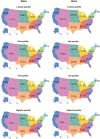Frailty in Older Adults: A Nationally Representative Profile in the United States
- PMID: 26297656
- PMCID: PMC4723664
- DOI: 10.1093/gerona/glv133
Frailty in Older Adults: A Nationally Representative Profile in the United States
Abstract
Background: Frailty assessment provides a means of identifying older adults most vulnerable to adverse outcomes. Attention to frailty in clinical practice is more likely with better understanding of its prevalence and associations with patient characteristics. We sought to provide national estimates of frailty in older people.
Methods: A popular, validated frailty phenotype proposed by Fried and colleagues was applied to 7,439 participants in the 2011 baseline of the National Health and Aging Trends Study, a national longitudinal study of persons aged 65 and older. All measures drew on a 2-hour in-person interview. Weighted estimates of frailty prevalence were obtained.
Results: Fifteen percent (95% CI: 14%, 16%) of the older non-nursing home population is frail, and 45% is prefrail (95% CI: 44%, 47%). Frailty is more prevalent at older ages, among women, racial and ethnic minorities, those in supportive residential settings, and persons of lower income. Independently of these characteristics, frailty prevalence varies substantially across geographic regions. Chronic disease and disability prevalence increase steeply with frailty. Among the frail, 42% were hospitalized in the previous year, compared to 22% of the prefrail and 11% of persons considered robust. Hip, back, and heart surgery in the last year were associated with frailty. Over half of frail persons had a fall in the previous year.
Conclusions: Our findings support the importance of frailty in late-life health etiology and potential value of frailty as a marker of risk for adverse health outcomes and as a means of identifying opportunities for intervention in clinical practice and public health policy.
Keywords: Epidemiology; Health disparities; Public health.
© The Author 2015. Published by Oxford University Press on behalf of The Gerontological Society of America. All rights reserved. For permissions, please e-mail: journals.permissions@oup.com.
Figures


References
-
- Saliba D, Elliott M, Rubenstein LZ, et al. The Vulnerable Elders Survey: A tool for identifying vulnerable older people in the community. J Am Geriatr Soc. 2001;49(12):1691–1699. 10.1046/j.1532-5415.2001.49281.x - PubMed
-
- Strawbridge WJ, Shema SJ, Balfour JL, Higby HR, Kaplan GA. Antecedents of frailty over three decades in an older cohort. J Gerontol B Psychol Sci Soc Sci. 1998;53(1):S9–16. 10.1093/geronb/53B.1.S9 - PubMed
-
- Rockwood K, Mitnitski A. Frailty in relation to the accumulation of deficits. J Gerontol A Biol Sci Med Sci. 2007;62(7):722–727. - PubMed
-
- Binder EF, Schechtman KB, Ehsani AA, et al. Effects of exercise training on frailty in community-dwelling older adults: Results of a randomized, controlled trial. J Am Geriatr Soc. 2002;50(12):1921–1928. 10.1046/j.1532-5415.2002.50601.x - PubMed
Publication types
MeSH terms
Grants and funding
LinkOut - more resources
Full Text Sources
Other Literature Sources
Medical

